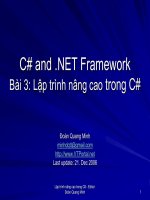Intro to advanced programming (lập TRÌNH NÂNG CAO SLIDE)
Bạn đang xem bản rút gọn của tài liệu. Xem và tải ngay bản đầy đủ của tài liệu tại đây (520.56 KB, 48 trang )
ADVANCED PROGRAMMING
(LTNC)
Course Topics – Java Basics
Declarations and Access Control
Data Types
Varialable
Assignments
Operators
Object Orientation
Flow Control, Exceptions
String
Khoa CNTT – ĐH Nông Lâm TP. HCM 01/2016
2/48
Course Topics – Java Basics
Class defination
Access modifiers
Inheritance
Overriding / Overloading
Object reference
Constructor and instantiation
Class and Object varialables
Khoa CNTT – ĐH Nông Lâm TP. HCM 01/2016
3/48
Course Topics – GUI (SWING)
Swing overview
Swing by examples
Swing components
Layout Management
Event Handling
Performing custom painting
More Swing Features and Concepts
How to use the Swing components
Khoa CNTT – ĐH Nông Lâm TP. HCM 01/2016
4/48
Grading
Attendance: 15%
Midterm exam: 35% (Lab)
Final exam: 50% (Lab)
Khoa CNTT – ĐH Nông Lâm TP. HCM 01/2016
5/48
Bibliography
1. Core JAVA, Volume I, Cay S. Horstmann, Gary
Cornell, Sun MicroSystem Press, USA 2008.
2. Core JAVA, Volume II, Cay S. Horstmann,
Gary Cornell, Sun MicroSystem Press, USA
2008.
Khoa CNTT – ĐH Nông Lâm TP. HCM 01/2016
6/48
Computer Program
Set of instructions written
in a programming
language that tells the
computer what to do
Khoa CNTT – ĐH Nông Lâm TP. HCM 01/2016
7/48
The Programming Process
Defining the problem
Planning the solution
Coding the program
Testing the program
Documenting the program
Khoa CNTT – ĐH Nông Lâm TP. HCM 01/2016
8/48
The Programming Process:
Defining the Problem
What is the input
What output do you expect
How do you get from the input to the output
Coding the Program
Translate algorithm into a formal programming
language
Within syntax of the language
Text editor
Programming environment: Interactive
Development Environment (IDE)
Khoa CNTT – ĐH Nông Lâm TP. HCM 01/2016
9/48
Languages
1. Machine code or machine languages
A sequence of 0’s and 1’s giving machine
specific instructions. Example: 00011001
Displayed as hexadecimal
Only language the computer understands
All other programming languages are translated
to machine language
Computer dependent
Khoa CNTT – ĐH Nông Lâm TP. HCM 01/2016
10/48
Languages
2. Assembly language
Using meaningful symbols to represent
machine code. Example: add hl,de
Names for memory locations
Computer dependent
“Assembler” translates from Assembly to
machine language
Assembler: Assembly code machine code
Disassembler: machine code assembly
code
Khoa CNTT – ĐH Nông Lâm TP. HCM 01/2016
11/48
Languages
3. High-level languages
Similar to everyday English and use
mathematical notations (processed by
compilers or interpreters)
Example of a C statement: a = a + 8;
High-level Languages and Their Inventors
FORTRAN John W. Backus, 1954
BASIC
George Kemeny and Tom Kurtz, 1964
Pascal
Nicolas Wirth
C
Dennis M. Ritchie
C++
Bjarne Stroustrup
Java
James Gosling
C#
Anders
Khoa
CNTT – Hejlsberg
ĐH Nông Lâm TP. HCM 01/2016
12/48
Popularity
Khoa CNTT – ĐH Nông Lâm TP. HCM 01/2016
13/48
Programming classification
Programming = Programming Language +
Algorithms + (Database)
Assembly
Java
C / C++
C#
Pascal
Language
Level
Khoa CNTT – ĐH Nông Lâm TP.
HCM 01/2016
14/48
ABOUT THE JAVA TECHNOLOGY
Java technology is both a programming language and a
platform
The Java programming language is a high-level
language that can be characterized by all of the
following buzzwords:
Simple
Architecture neutral
Object oriented
Portable
Distributed
High performance
Multithreaded
Robust
Dynamic
Secure
Khoa CNTT – ĐH Nông Lâm TP. HCM 01/2016
15/48
ABOUT THE JAVA TECHNOLOGY
In the Java programming language, all source code
is first written in plain text files ending with the
.java extension. Those source files are then
compiled into .class files by the Java compiler
(javac). A .class file does not contain code that is
native to your processor; it instead contains
bytecodes-- the machine language of the Java
Virtual Machine. The Java launcher tool (java) then
runs your application with an instance of the Java
Virtual Machine.
Khoa CNTT – ĐH Nông Lâm TP. HCM 01/2016
16/48
ABOUT THE JAVA TECHNOLOGY
Khoa CNTT – ĐH Nông Lâm TP. HCM 01/2016
17/48
JVM – Java Virtual Machines
Virtual machines depend on specific platforms
(hardware, OS)
Provide Java programs with (platform independent)
run-time environments
Ensure system security
Normally provided as software
JRE - Java Runtime Environment
Java platform: JVM + APIs
18
Khoa CNTT – ĐH Nông Lâm TP. HCM 01/2016
18/48
The Java Runtime Environment
The Java application environment performs as
follows:
19
Khoa CNTT – ĐH Nông Lâm TP. HCM 01/2016
19/48
JVM™ Tasks
The JVM performs three main tasks:
–
Loads code – Performed by the class loader.
•
•
–
Verifies code – Performed by the bytecode verifier.
•
•
•
•
•
–
Loads all classes necessary for the execution of a
program.
Avoids execution of the program whose bytecode has
been changed illegally.
The code adheres to the JVM specification.
The code does not violate system integrity.
The code causes no operand stack overflows or
underflows.
The parameter types for all operational code are correct.
No illegal data conversions have occurred.
Executes code – Performed by the runtime interpreter.
20
Khoa CNTT – ĐH Nông Lâm TP. HCM 01/2016
20/48
Environment
21
Khoa CNTT – ĐH Nông Lâm TP. HCM 01/2016
21/48
JDK – Java Development Kit
Free development and run-time environment
provided by Sun Microsystems ()
Most widely used Java software development kit
Main components:
–
–
–
–
–
–
javac compiler, converts source code into Java
bytecode
java interpreter and application loader
appletviewer interpreter, run and debug Java applets
without a web browser
javadoc documentation generator, automatically
generates documentation from source code comments
jdb debugger
javap class file disassembler
22
Khoa CNTT – ĐH Nông Lâm TP. HCM 01/2016
22/48
Types of Java applications
Desktop application – Java SE (Java Standard
Edition)
–
–
Server application – Java EE (Java Enterprise
Edition)
–
Java Application: normal Java application running
on desktops; console or GUI
Java Applet: embedded application running
within Web browsers
JSP và Servlet, JSF, EJB
Mobile (embedded) application – Java ME (Java
Micro Edition)
Java Card
23
Khoa CNTT – ĐH Nông Lâm TP. HCM 01/2016
23/48
Java Desktop Applications
Complete application programs
Console or GUI
Launched by java command
24
Khoa CNTT – ĐH Nông Lâm TP. HCM 01/2016
24/48
A Sample Java program
TestGreeting.java
Declare new class
same name with class
commented line
// This is a simple program
main method from
where the program
begins its execution
public class TestGreeting {
public static void main(String[] args) {
System.out.println("Hello, world");
}
}
object
message
displays the string Hello,
world on the screen
25
Khoa CNTT – ĐH Nông Lâm TP. HCM 01/2016
25/48









